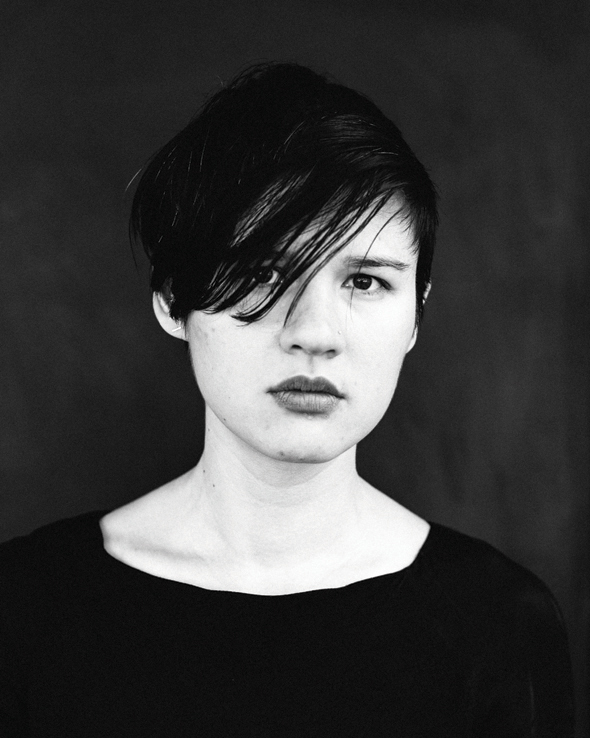
Since her breakout collection in 2010 that featured vegetable and rust dye techniques, the evolution of fashion designer Titania Inglis has been in stride with that of industry disruptors like Vivienne Westwood and Zandra Rhodes. Growing up in Ithaca, New York among woodlands and waterfalls, Titania was an environmentalist long before she became what she likes to refer to as a “thoughtful” designer—taking into consideration the long-term impacts of her creations on people and planet.
Thoughtful as they are devastatingly beautiful, Titania Inglis’ ethereal designs deliver a modern antidote to mundane and brutally basic wardrobe staples. Consisting of transitional dresses, jackets and separates that can be worn from day to night and spring to winter, each style embodies a dark, into-the-woods elegance that’s minimalistic while grounded in geometry and ease. Inglis’ collections are made in New York at a small family-owned factory from high quality materials that are ethically sourced from around the world, such as Japanese organic cotton, veggie-tanned leather, deadstock wool derived from New York’s Garment District, and wood pulp-based cupro twill. Some garments are even dramatically hand-painted in her Brooklyn based studio, with non-toxic silkscreen inks, to achieve a dip-dyed, smudged technique.
Currently, Inglis gracefully juggles teaching curricula like zero-waste design at Parsons New School for Design with that of running her self-named sustainable fashion label. The recent launch of a dreamy bridal collection that challenges the nuptial status quo, has put her on the radar of free-spirited brides-to-be everywhere.

When was the moment you knew you wanted to be a fashion designer?
It was a gradual process of convincing myself that I had something to say to the world through clothing; the days I’m most sure I love this are the ones where I’m hands-on in the studio developing a new piece, or when I get to witness the delight in a client’s eyes as she first tries on her finished garment.
What were you hoping to bring the fashion industry when you launched your first solo collection in 2009?
My goal was to create beauty, both aesthetically and in the world: using thoughtful processes to create a line combining a dark, sophisticated aesthetic with a positive impact.
You’ve worked alongside New York cult designers Camilla Stærk, Jean Yu, and ThreeASFOUR. What did you take from these experiences as an apprentice that reflects in your work?
ThreeASFOUR’s constant experimentation was a thrill to be a part of, and I seek to bring that spirit of fun and sense of wonder into my own work. Jean Yu’s sophisticated fabrics, innovative draping, and exacting attention to detail taught me how to make the simplest designs simply exquisite.
You grew up in Ithaca, NY, studied in Denmark and the Netherlands and now reside in Brooklyn. How did those surroundings influence your design aesthetic?
I’d like to think I combine them all: Ithaca is a magical hideaway full of woodlands and waterfalls, while Denmark is the home of modern design given warmth through natural materials and very human contours. The Dutch are genius at twisting classical references via modern technology, and Brooklyn is a creative melting pot and unending source of inspiration, resources, and collaborators.
Can you describe your unique creative process?
I glean inspiration from everywhere and nowhere: Grimes, Jarmusch, Ando, topological maps, cracks in the sidewalk, new fabrics I’ve sourced — and combine those into a mood board. With that feeling in mind, I develop new techniques with my materials, and then drape to see what those altered materials want to do on the female form. I’ll fit on a model, my assistants, friends, and myself to see how the piece works on various body types, and then my longtime sewing house will make up the final sample. The ultimate goal is beauty, versatility, and comfort.
How did your line evolve into bridal and how does it cater to the social demand for a new kind of bride and less traditional wedding ceremonies?
Almost from the start, I’ve included white dresses in each collection, primarily to showcase the beauty of the natural fabric. As brides started gravitating toward them, I realized that it was offering them an option outside of the expected—simple, stunning dresses that reflect a woman’s personal style, that don’t cost thousands of dollars and that she can continue wearing the rest of her life.
In addition to being beautifully crafted, your collection is made locally with ethically sourced, environmentally friendly and natural materials. Why was this important to you?
Let’s shift the norms here: Why not instead ask other brands why they choose to work irresponsibly? Sustainability, by definition, means creating something that can continue, considering the long-term consequences of one’s actions. So working unsustainably is literally not an option.
Text by Andrea Plell
Portrait by Eric Morales
Photograph by Julia Comita

